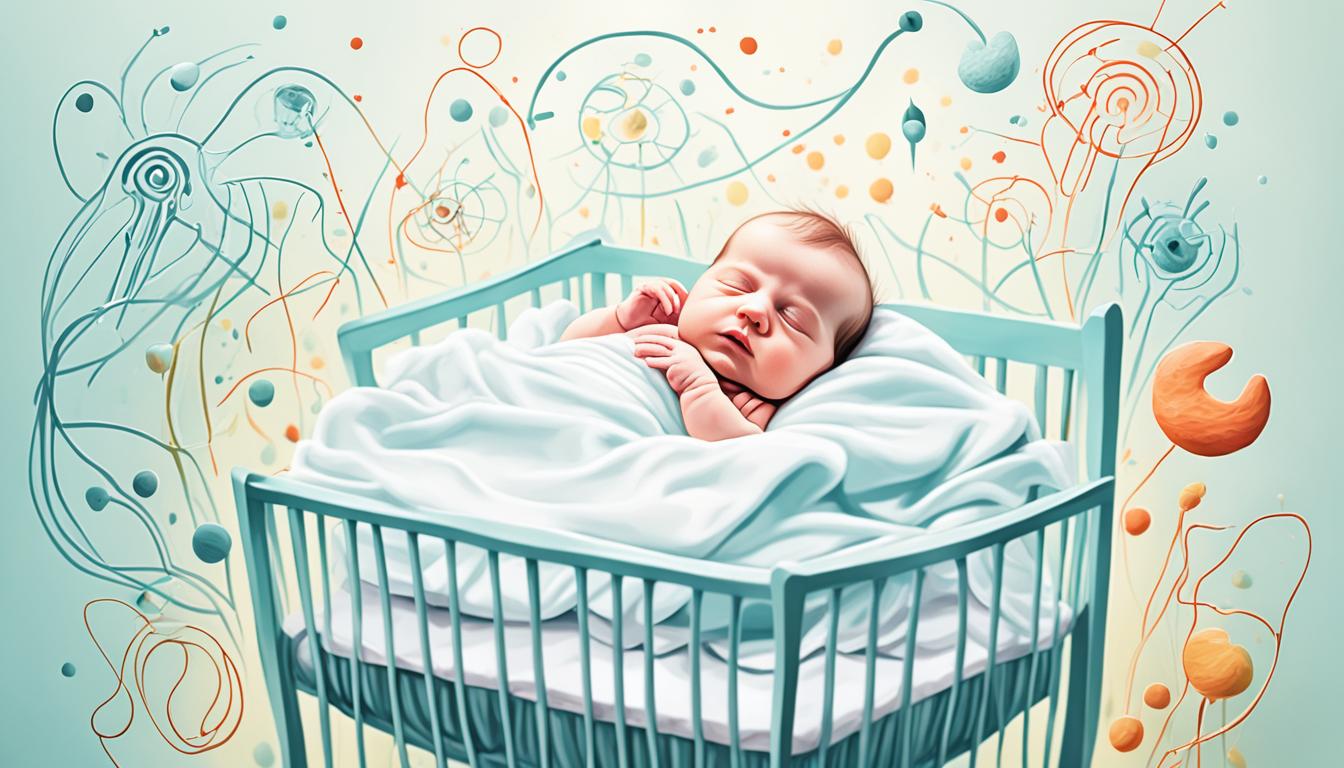Sudden infant death syndrome (SIDS), known as crib death, is a devastating and mysterious event. It happens when a baby under 1 year old suddenly dies. This occurs without a clear cause, even after a deep investigation is done. It’s a tragedy that happens around the world, drawing attention to how we understand and tackle this issue is vital.
SIDS is the top reason for infant death after the neonatal stage in the United States. Most cases happen in the first six months of life. Even though the reason is not completely clear, certain risk factors have been found. These include the baby sleeping on their side or stomach, being born early or small, getting too hot while sleeping, and sleeping on soft beds with loose bedding. Also, if there’s a family history of SIDS, the chances might be higher.
There are steps parents can take to lower the risk of SIDS. Putting the baby to sleep on their back is crucial. Using a firm mattress and clean, fitted sheets in the crib is important too. Make sure the sleeping area is clear of loose bedding and toys. Having a smoke-free space and ensuring the baby does not get too warm while they sleep is also advised. Getting good prenatal care early on can help lower the risk too.
Boston Children’s Hospital works hard to learn more about SIDS. They do lots of research to understand its causes, risks, and any possible gender differences. Through this work, they aim to discover ways to prevent SIDS. They also look for treatments that may help families who have experienced this heartbreaking loss.
Key Takeaways:
- Sudden infant death syndrome (SIDS) is the unexpected death of babies under 1 year old.
- SIDS is the major cause of death in a baby’s first year in the US, mostly in the first six months.
- Things like baby sleep positions, early birth, and getting too hot while sleeping increase SIDS risk.
- To lower SIDS risk, ensure the baby sleeps on their back in a clear crib and keep their sleep area smoke-free.
- Boston Children’s Hospital leads in SIDS research, exploring the causes, risks, and gender aspects of this tragedy.
Diagnosis and Treatment Options for Crib Death
Sudden Infant Death Syndrome (SIDS) is deeply investigated when a baby dies. This includes looking at the body in an autopsy and where it happened. Doctors also check the baby’s medical records. They try to find out what caused the death by process of elimination. This is because SIDS does not have a clear sign.
Right now, there is no specific way to treat SIDS. But, there’s hope in using stem cells to help these young patients. Stem cells can fix and rebuild body tissues. This could be a major step in finding a real way to help those with SIDS.
Boston Children’s Hospital leads in studying SIDS and how stem cells might help. They are determined to find real hope for families worldwide hit by this tragic loss. This shows their strong drive to make a difference in this area.
Prevention and Safe Sleep Practices to Reduce the Risk of Crib Death
To protect your baby while sleeping, follow important practices to prevent Sudden Infant Death Syndrome (SIDS). Always lay your baby on their back. Studies show this lowers SIDS risk.
It’s also key to have a safe sleep spot for your little one. Use a firm mattress with only a snug sheet. Stay away from loose items like blankets, pillows, and toys in the crib to avoid danger.
Keeping a smoke-free home is vital. Secondhand smoke raises SIDS chances. If anyone smokes, they should do it outside to protect the baby.
Breastfeeding helps reduce SIDS risk, too. If you can, choose this. But, remember, sticking to the other safety tips lowers the risk, even without breastfeeding.
By following these safety steps, you create a safe sleep area for your baby. Remember to place your baby on their back, use a firm mattress, and avoid hazards in the crib. Keep the air clean and think about breastfeeding for extra protection. Safety for your baby is critical, and these steps help prevent SIDS.
FAQ
Q: What is crib death?
A: Crib death is also known as Sudden Infant Death Syndrome (SIDS). It’s the sudden, unexplained death of a baby under 1 year old. This happens even after a careful look into what occurred.
Q: What are the risk factors for SIDS?
A: Some things increase the chance of SIDS. These include placing a baby on their side or stomach to sleep. Also, being born early or too small, getting too hot during sleep, and laying down on soft things like loose blankets and bumpers.
Having a family history of SIDS or trouble growing can also be a risk. It’s important to be aware of these dangers.
Q: How is SIDS diagnosed?
A: SIDS is diagnosed after careful investigation. This involves an autopsy, examining where the death happened, and the baby’s health records. Since there’s no clear sign of SIDS, doctors rule out other causes.
About a third of SIDS cases have no clear reason for the baby’s passing. This makes it even harder to understand and prevent.
Q: Is there any treatment for SIDS?
A: Unfortunately, there’s no known cure for SIDS yet. But, new developments in stem cell therapy might change this. Stem cells can help repair damaged organs in SIDS cases. This may open up new doors for treating the condition.
Q: How can SIDS be prevented?
A: To reduce the risk of SIDS, take some basic steps. Put your baby to sleep on their back. Use a firm sleeping surface and keep their sleep area clear of blankets and toys.
Make sure the air is free of smoke and not too warm. Breastfeeding can also lower the chance of SIDS. These steps are simple but crucial for a baby’s safety.

